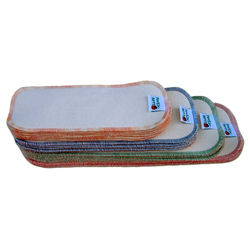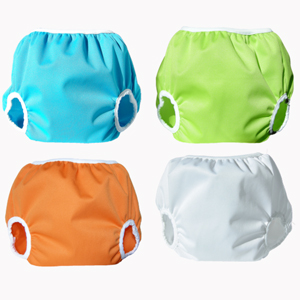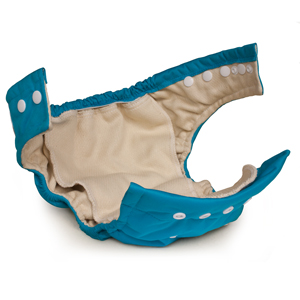Today I am going to provide information and links to help sort through the different style of cloth diapers. Because every baby and family are different; different shapes, different needs, different preferences, I will share the diapers that I have seen work for my baby and for many other families- but please try for yourself and see what works for you. There is a learning curve and it’s good to experiment a bit.
First, let’s review the options when it comes to cloth diapers. For the most part, these are your choices:
- Old fashioned pre-folds or flats: Flats are basically squares of cotton or flannel that you fold and twist as needed to fit your baby. Pre-folds are what most of us might think of as an “old fashioned” white fabric diaper. They have a reinforced center section, and are made of a few layers of cotton. They used to be held on with safety pins, and you would pull some rubber pants (that looked like a thick shower-cap with leg holes) on over the top to keep the baby’s clothes dry. Now, pre-folds can be fasted with special clips instead of pins, and there are more options for covers.. Some people just LOVE the good old fashioned pre-folds with a cover. I find them to be more cumbersome and not as cute- but that’s just me. The benefit of these are, the fit is completely custom since you fold each diaper yourself, and they are super affordable. Some families use these for the newborn stage, when babies have smaller amounts of urine but need frequent changes. Later, the pre-folds can be used as rags or wipes, or as stuffing for pocket diapers or All-in-twos. Here’s a link to a helpful blogger who loves to use pre-folds. She includes lots of pictures and ideas about cloth diapering: http://diaperpages.com/index.php
- Inserts: absorbant pads made of hemp, wool, cotton, microfiber, fleece, or some combination. Different materials have different benefits. Natural fibers tend to be more breathable and also more absorbent. However, they can get very heavy and dry more slowly when laundering. Cotton or hemp inserts may hold moisture against baby’s skin more than synthetics, and may contain oils which require you to pre-wash them and “break in” your inserts before use. Microfiber or fleece tend to wick moisture away but can’t hold as much liquid, and they have a tendency to develop odors. These are not used alone- they make up the absorbent core of a diaper, but need some kind of cover or shell to hold them in place. The popular cloth diaper brands sell inserts as part of their systems.
- Diapers Covers: This is a pretty diverse category. Covers can be made of all types of material. Usually a cover is made of a waterproof material, or a soft fabric with a waterproof liner such as PUL. There are also covers made of wool. The cover goes over an absorbent under layer of some kind. This layer either fastens around the baby (fitteds), or sits inside of the cover (inserts/all-in-twos, or pre-folds).
- More on diapers that need covers: Fitted diapers are soft diapers that use snaps/elastic/velcro to provide fasteners and fit, but are not waterproof. All-in-twos are systems made up of a cover or outer pant, and an absorbent insert that lays in the cover like a hammock. These are very diverse systems. Diapers such as the “flip” or “gDiapers” are examples of this system. Oftentimes these systems have an option for disposable inserts, which is pretty cool. gDiapers, which I get into later, offer a flushable and compostable option. Here is a video showing how all-in-twos work, as the shell is reusable and the inserts are replaced. She gets into a lot of detail about the different types of all-in-twos and the logistics of changing them: http://dirtydiaperlaundry.com/intro-to-cloth-diapers-all-in-twos/
- All-in-Ones: These are cloth diapers that are entirely one piece. The whole thing comes off when you change and is laundered as one piece. They can take awhile to dry. The size of the diaper and level of absorbency are generally not very flexible.
- Pocket Diapers: These diapers have an outer cover with a pocket or sleeve built in. The insert goes into the pocket, at which point the diaper stays together as one piece. The insert is removed when you launder your diapers and replaced when dry. These are very easy to use, and you can customize the type/thickness of insert that works best for you. These are very common and easy to find, and are the cloth diapers I’ve found most people like best. BumGenius, Fuzzibunz, and Thirsties all make popular pocket diapers. Generally if you find homemade diapers for sale on etsy, or cloth diapers for sale on zulily, they are pocket diapers.
If you are interested in reading even more about types of cloth diapers, and their various pros and cons, you can check out this fabulous website. Fair warning, when I first encountered it I kind of went down a rabbit hole. I couldn’t stop reading her various information about cloth diaper products that I’ve never used before: http://soeasybeinggreen-blog.com/types-of-cloth-diapers/
My Recommendations
I have tried dozens of types of cloth diapers. My first were the old fashioned prefolds with pins, back when my baby sister was in diapers. While working with infants and toddlers in an NAEYC accredited early childhood center, I had the chance to see almost every type of cloth diaper under the sun, and I quickly learned which brands worked best for the majority of kids and families. Here’s my two cents:
BumGenius
BumGenius diapers are the best of the best. I like the BumGenius 4.0 One Size Diapers. They have options to fasten with snaps or the hook and loop (velcro) closures. I like both. They are a pocket diaper, which means that the insert comes out for laundering, and is stuffed back into the diaper before use. These make up the majority of my stash.
Pros: BumGenius diapers have a versatile, adjustable fit, which means the same diaper can fit on a 3 month old and a three year old. They stay secure even on mobile children, they are easy to put on but not easy for a child to remove themselves. BumGenius diapers have minimal leakage. They are the least leaky cloth diapers I am aware of (comparable to disposables in my experience, if they are changed ever 2-4 hrs). These diapers come with two inserts each, so you can customize the size for smaller babies or heavy wetters. The BumGenius pockets are favorites of people who don’t like cloth diapers, and these were the preferred diapers at the child development program I worked at, because they are so similar in style and function to disposables. It is easy to take it off of baby and throw the whole thing into a diaper pail, without having to come into contact with the contents in any way. If your partner is at all squeamish about cloth diapers, these might be a good choice. They also stand up well to washing, drying, and occasional bleach use.
Cons: They are more expensive than some other brands, running 15-25 dollars per new diaper, but they have a higher resale value and longer life as well. They are fairly thick, so they take up a fair about of drawer or diaper bag space, and add some puff to baby’s bottom (which can be nice when they are in the falling-down-often stage). I think it’s worth it because they are absorbent and don’t leak. The inserts are microfiber, which are lightweight and help keep baby dry, but they are more prone to odor retention and aren’t as absorbent as some natural fibers. Because these are pocket diapers, there is an added step of re-stuffing the diapers before use. It takes very little time and effort, but is something to be aware of.
See their website for diagrams, pictures, and more details about their great diapers: http://www.bumgenius.com/
gDiapers
gDiapers are another brand that we love and regularly use. They are pretty different from the BumGenius pocket diapers. Here is how: gDiapers consist of three parts. There is a super absorbant insert, which goes against baby’s bum and is made of fleece and hemp, there is a waterproof liner that holds the insert and keeps moisture from leaking through to the outside of the diaper (like a hammock), and there is a cute cotton cover, which secures the diaper around baby and creates a snug fit around the waist and legs. gDiapers are unique in that they have a hybrid option. The company website can explain in further detail what the specifics and limitations are, but basically, they make both cloth and disposable diaper inserts. The disposable inserts they make are free of harmful chemicals and are fully compostable, or they can be flushed down the toilet!
gDiapers come in different sizes- S, M, L, and XL (as opposed to the BumGenius, which come in one adjustable size). I didn’t start using them until my daughter could wear the mediums. I didn’t want to buy the smalls because I figured she would outgrow them quickly (they are good for up to 14 lbs). The mediums have some stretch and flexibility. It says they are good for 13-28 lbs, but I know people who have used when their baby was as light as 10lbs, and continued with them until their child was over 30lbs- and hopefully we’ll be close to potty training when that time comes! Some people have told me these are their favorite newborn diapers though, so it might be a worthwhile investment to get a few small covers.
Pros: These diaper inserts are the best I’ve found. The fleece layer is soft and moisture wicking against baby’s bum, and the hemp is unbelievably absorbent. The hemp is also odor resistant, and I have not experienced any lingering odor at all- which sometimes does happen with microfiber liners. These diapers have a trim fit, and much less bulk than any other cloth I’ve tried. It almost looks like baby is wearing thick training pants. When you change baby, you stick the wet insert into your diaper pail or wet bag, and keep using the liner and cover (unless they are very wet or soiled). This means less laundry, and less bulk in your wet bag if you are out and about. The cotton cover has a nice, natural feel, and the colors are really adorable. Along with being less bulky, these diapers are more breathable. We’ve found them to be a great option when baby has a rash. The hemp inserts, covers, and liners are all very small, so a day’s supply can easily fit into a diaper bag. They are a really nice choice for travel. Having the flushable/disposable/biodegradable insert as an option has also been very nice for travel, or for days when there is no clean laundry. Because you re-use the covers, you don’t need to purchase as many. Lots of people say that 6-7 covers is all you need (as opposed to the pocket diapers, where you launder ever diaper and insert with each use). Some people love that these diapers fasten in the back. Now that I have a little squirmer, I do find them easier to put on. The “hook and loop” fasteners (like velcro) are the sturdiest and best quality I’ve ever seen. If you have a kid who unfastens their own diapers, these are supposed to be the most impossible to remove. The covers and liners also dry super quickly.
Cons: You have to touch the wet insert when you are changing baby. It’s not a big deal – I use my cloth wipe to scoop it up. And you should be washing your hands after every change, regardless. They are a bit more leak prone than some of the pocket diapers- I have not had success using them as nighttime diapers, and there was a learning period of a day or two before I got the hang of how the inserts should fit into the liner. Because they are so trim, depending on your baby, gDiapers may need to be changed a bit more frequently- 2 hours is fine, but 3.5 hours is the max I’ve gone without getting a leak. The hemp inserts, while super aborbant, also take a bit longer to dry in the dryer. I’ve never tried line drying, but imagine it would take a full day or more. Some of the cotton covers seem prone to fading with lots of laundering. I’ve noticed it with the gray in particular (It shouldn’t be necessary to bleach them, but if you do, obviously they will fade). Depending on when/how you use these, you may need to buy a few different sized covers. The inserts however, are the same for the M, L, and XL size, so you don’t need to replace the entire system.
So much more info (and sales and package deals) on their great website and through their facebook group: http://www.gdiapers.com/
Other Popular Options:
I have heard lots of great feedback about Alva cloth diapers. I have had good experiences in the past with Fuzzibunz, which are pocket diapers with adjustable waist and leg gussets (a unique feature). They work well on smaller babies, and babies with very small bottoms or skinny legs. With my particular baby, for some reason, they were prone to leaks and rashes.
Getting Started. Trying and Buying Your Cloth Diapers:
Ok, so, you are intrigued. You want to give cloth a try. But where to start? If you plan to go all in and want an entire set of cloth diapers, and you don’t plan to do laundry every day, you will probably need 20-30 diapers total. That allows for some in your diaper drawer, some in your diaper bag, some dirty ones in the pail, and some in the laundry. I usually wash diapers every 2-3 days. This prevents me from totally running out, and keeps diaper stains and odors down.
If you know what kind of diaper you want to use, you can search online and often buy a whole set at a discount from distributors. Amazon and Target actually carry a wide variety of cloth diapers, which you can add to your registry, or track in case they go on sale.
There are also programs for you to try out a variety of new cloth diapers and see what you like. With these trial kits, you pay a deposit, receive a variety of cloth diapers to try, use them, and then return them after a set period of time, at which point you get money back. Jillian’s Drawers is a website with a trial system: http://www.jilliansdrawers.com/products/clothdiapers/tryclothfor10/tryclothfor10
Lots of moms find deals on entire sets of cloth diapers on ebay or craigslist or through shop and swap groups. These are usually heavily discounted and contain at least a few different types. There are cheaper, non-name brand versions of most styles of diaper, and while the quality or fit may not be as good, you can get an idea about whether you like an all-in-two or an all-in-one, etc.
There are also cloth diaper co-ops, where groups of Moms order diapers and baby supplies together to get them at a cheaper rate. I’m in one, and it’s awesome! You can search for these in facebook.
If you are the crafty type, you can even try making your own diapers or covers. There are tons of patterns available online, and many work-at-home moms have their own Etsy shops selling their cute handmade creations.
My advice is, look at the options, think about what features are most important to you, then get your hands on some diapers and see what appeals to you. I think if you give it a try, you will be really happy with the results!
Also, keep in mind, this is not an all-or-nothing arrangement. For many families, it makes sense to use disposables some of the time. Some families use them when their babies are very small (I used biodegradable disposables until my daughter weighed 12 lbs and had a good fit from my BumGenius pocket diapers). Some families prefer to use disposables at night, or when their child is with another caregiver. Do what makes sense for your family. At this time, I am cloth all the way- even when I travel or am hiking. But I also know that I need my diaper system to be functional and it shouldn’t feel like torture, so if I need to be flexible in the future I will. Even if you use cloth for just the first year, or some of the time, you will be saving money, making a great choice for your baby, and helping our planet. In the end, that’s my goal. I want to show my baby a peaceful, loving lifestyle, and help preserve the planet so that she can enjoy it with her children some day.
Coming soon: Cloth Diaper Gear (wetbags, sprayers, cloth wipes, etc.), Laundry Routine, and Problem Solving Common Issues
Related articles
- How-to: Making Cloth Diapers (yourbabynannynyc.wordpress.com)
- Cloth Diapering 103 | Diaper Rash Remedies (sweetpeasandsoybeans.com)












